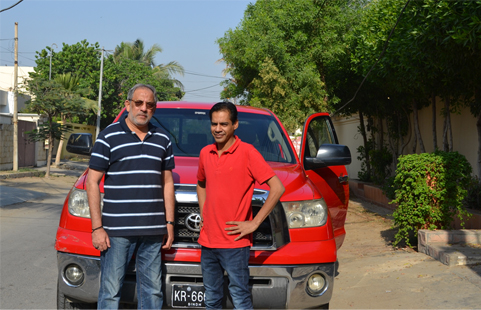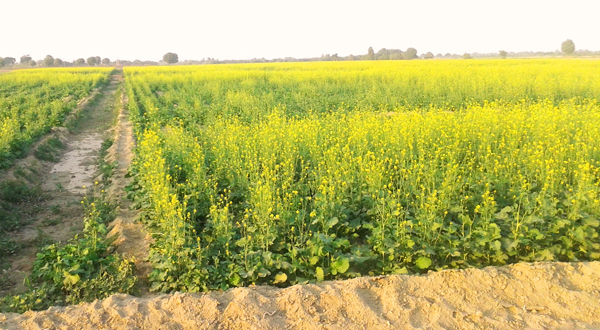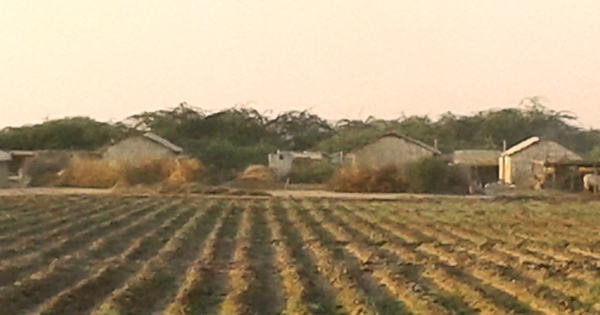The Kunri Report
Note: This is a follow up to my previous blog, Ladies and Gentlemen, Meet Aansoo Kohli
Leaving the Super Highway just outside Hyderabad city and taking the bypass to Mirpurkhas, dense mango orchards greet you. You drive past Sindh Agricultural University Tando Jam, with its imposing buildings and immaculate grounds. Just before Mirpurkhas you take a side road to Kunri. Along the way, are fields of sugarcane, banana, mustard, onions, other veggies and then finally around Kunri, fields of red chili, for Kunri is one of the top red chili growing areas in Asia.
In Kunri Town we meet up with our contact, Janib Dalwani, a slight young man of about 30 years. His welcome is warm and he insists we must first have a cup of tea with him before starting off for Aansoo’s village. He quickly tells us his own life story and then Aansoo’s, and then talks about her school and all the very latest developments. A very milky doodh-patti later, we are off to the village. A kilometer out of Kunri, we leave the road and take a dirt track through barren, sandy countryside, raising huge clouds of fine sandy dust. Twenty minutes later we are at Aansoo’s village.
Aansoo, born into a dirt poor hari (farm labour) family had an innate desire for education from childhood. Her father supported her, even though at age 2 already she became practically incapacitated in one leg because some ‘wrong’ injection was given to her. When she was in Matric (10th grade), her father passed away. Her mother continued to support her, working extra long hours in the fields to do so. Aansoo cleared her Intermediate (high school) and is currently in B.A. Part 2 at the Government Girls College, Kunri, with political science as her major.
About 7 months ago Aansoo made a major decision in her life; she resolved that whatever it takes, she will educate the scores of malnourished and barefooted children of her village. She set up a class in the family cowshed during the day when the animals were out in the fields. From about 10 children at the start, her class is now some 200 pupils strong and runs in 2 shifts. There are 3 or 4 long narrow benches that seat about 30 or 40 kids. The rest sit on the bare earth. Enthusiasm is strong. As we alight from the vehicle and walk into the cowshed classroom, a host of children, boys and girls, all get up and in perfect chorus greet us with, ‘Good morning Sir!’
Totally unexpected and totally overwhelming! I look around at the shy but smiling faces. God only knows what they were told about who was going to visit or why. But from their expectant, curious expressions it is clear that they know our visit has something to do with their ‘school’. I see a young woman walking with a crutch approaching. Aansoo is accompanied by her mother, a couple of her six brothers and several other adults of the village. Pleasantries exchanged, we get into discussion.

Group photo in the classroom. Myself in the center with Shiva, Aansoo’s nephew in my lap. Aansoo and her mother on one side, Janib on the other, and the pupils of the school gathered all around
At the start of her mission, Aansoo approached a local notable for support. He gave her a hundred rupees. Aansoo has never spent the money and keeps the single banknote as a memento. She tells wryly that earlier, other notables used to have pity on her disability and give her five rupees.
Janib has been her strongest supporter throughout. Over the months he has pleaded her case with everyone who matters in the area and even taken her case to one education minister of Sindh; all to little avail. Then on November 02, reporter Sameer Mandhro of Express Tribune did his first story on Aansoo. I missed it, but many others didn’t. People woke up. The NGO, Sindh Education Foundation made contact, donated books and perhaps gave some other support. An MNC gave a donation. I am not sure if it was cash or materials. A senator donated two hundred thousand rupees!
Aansoo has parked the good senator’s donation in a bank account and will not use it immediately. Instead she will use it as she goes along, mainly for salaries of 2 teachers she has now taken on board, and for setting up similar ‘schools’ in neighbouring villages, motivating and engaging other young people like herself to take ownership of their own village schools. If this is not vision, then I don’t know what vision is.
Then Sameer does a follow up story on November 12. I read this one and wrote a post on my blog www.bobbhai.com, proposing a simple and doable support plan for Aansoo. God bless all you goodhearted people who responded and have made your contributions; from Karachi and Lahore and London and Canada and the USA. Those who pledged but still have not paid, may please do so before the cutoff date of November 30.
I tell her that a group of friends and well-wishers have put together a sum of money. It may not be too much, but it is what we could collect immediately. What are the priority things she needs?
Benches to seat all kids and a proper classroom were Aansoo’s top priorities until a few days ago. Now someone has promised the benches already. She does not need books immediately as she has built up a stock. Yes, she would ideally like all the kids to have uniforms. And clean drinking water supply. But most of all, she needs to have proper premises. Can we build her one?
I am in a bit of a quandary now. The plan was not to give a cash donation but procure and supply needed materials. I consult Janib. He points at the dwellings in the village. All made of clay and husk composted walls, sun-dried to hardness. The roofs are of a lattice of bamboos or long, straight branches, covered over with a thick layer of palm fronds or similar, and then covered over with the same tough paste of clayey mud and husk.
Using village labour itself, we can easily build an all-weather classroom like this, with attached toilets, Janib says confidently. I am in a fait accompli situation. To construct such a permanent one-class school for Aansoo with local materials and local manpower is quite obviously the most logical and inexpensive and quickest solution. But this will mean giving cash to Janib / Aansoo, something that the plan had specifically ruled out. I feel a strong urge to trust them completely and confirm that the funds will be given very soon. But the money is not mine. There are many other contributors. So I tell them that in all probability it should not be an issue for our small group to bear the school construction cost, but I need to check back with all supporters and will revert.
We discuss what can be done with the money left over once the construction is done. Aansoo wants the kids to have uniforms. I want them to have uniforms. Each and every of the 200 or so of them. These are kids who do not have regular daily access to clean drinking water. What will a uniform do for them? I pondered for a moment only and concluded that it will do a huge lot and much more than one could imagine at first thought. The uniform will become the village child’s proud and most precious possession. It will give the child an identity and a sense of achievement. It will highly motivate the wearer to continue with schooling beyond Aansoo’s classroom-school. It will do even much more. I leave it to you to think for yourself.




Is the donation still continuing. What is the current requirement now?
Kashif,
I am currently abroad and will return to Karachi mid month. Then will start new fundraising for 2 sets of uniforms for about 200 kids. Cost will be about Rs. 1000 per kid or Rs. 200,000 for 200 kids. We believe uniforms will give the kid a great sense of pride, and of belonging to an institution. So if you wish to contribute for the uniforms collection, please do let me know. And do also please try and get your family and friends also contribute, so that we achieve the total required as soon as possible. Thanks